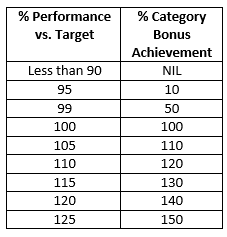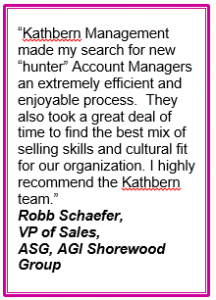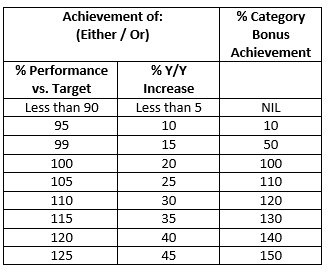In our most recent article, we explained what a powerful tool a good bonus system can be and, when constructed properly, how it can power an organization forward to levels of success that would otherwise be unattainable.
Refresh your memory and read more here: Management’s Secret Weapon – Bonus Systems
What are the key elements of an effective bonus system?
- Set the OTB Percentage of Base Salary
The On-Target Bonus (OTB) Percentage is the bonus amount that will be awarded if the employee meets 100% of the bonus objective. If the OTB percentage is set at 30% and base salary is $100,000 then an on-target performance will result in a bonus of $30,000. The OTB percentage should be set consistently across an entire class of employees (e.g., all sales reps or all field technicians) and can differ widely from class to class depending on the degree to which that group can impact success based on their own initiative. It is also dependent on what is determined to be the “appropriate” level of employee initiative that is desirable in pursuit of achieving certain goals. In some circumstances, a very aggressive approach may be desirable and therefore a high OTB percentage such as 50% or even 100% might be appropriate. In other circumstances, the organization may feel that employees should take a softer approach and so the OTB percentage might only be 5% or 10%. - Create up to Four Rating Categories For Your Bonus System
Careful consideration must be taken to develop rating categories that encompass the most important measurable (or rateable) aspects of the employee’s responsibility.
For a sales rep, categories might include:
– $ sales volume
– Customer returns/complaints
– Training goal achievement
– Teamwork -
Set the % Weighting For Each Category
Each category is likely not equal in importance, so the relative importance of each category is assigned a % weighting such as:

- For Each Category, Determine the Criteria for 100% Success,
Underachievement and Overachievement Within The Bonus System
For example, for the category “$ Sales Volume”, the 100% achievement target might be set at $2.0 million. Achievement of this sales level would then result in 100% achievement of this bonus category which, in this example, would be worth 75% of the total OTB Bonus amount or $22,500 ($30,000 x.75).
Other payout levels should also be set to anticipate under and overachievement such as:

Note that no bonus is earned for performance that is less than 90% of target, however a partial bonus is earned as performance rises above 90%, achieving full bonus amount and 100% performance and then accelerating  disproportionately as performance exceeds the target level.
disproportionately as performance exceeds the target level.
For categories that do not involve easily measurable results such as the “Teamwork” category in this example, it is necessary to develop a “1-5” rating system with clearly defined criteria as to what each of those rating categories means and to clearly communicate those criteria to all involved.
- Consider the Use of Absolute Targets and % Y/Y
Improvement Targets in an Either/Or Fashion
The above example of bonus payouts for the “% Sales Volume” category uses absolute numerical results. On occasion, such as when an entire team has been given the same numerical target in order to achieve 100% achievement ($2.0 million in this example), it may be wise to provide an alternate pathway to success based on % Y/Y improvement. This approach can accommodate differences due to territory size or difficulty.
An example of this is as follows:

- Create a Bonus Calculation Worksheet for Each Person
For everyone in the bonus system, an individual worksheet sets out the level of achievement for each category, the weighting and the resulting bonus payout.
Here is an example:

- Set Annual Targets but Payout More Frequently on an Adjusted YTD Basis
The motivational benefit of the bonus system is dependent on timely and relatively frequent feedback. This is best achieved by payouts that are monthly or quarterly rather than annual. Yes, this is more work and makes the program more complex but the benefit is worth the effort.
To have annual targets but more frequent payouts, an additional aspect must be added to the worksheets. For a quarterly payout system, the annual targets and bonus potentials must be divided by four and the quarterly actual results compared to these quarterly targets on a YTD basis. For each succeeding quarter, an additional quarter’s worth of potential and actual results is added so that at end of the second quarter the YTD results are compared to the YTD targets. The resulting bonus at the end of the second quarter is the combined second quarter bonus for all categories LESS the payout for all categories that was awarded for the first quarter. And so on.
Some might worry that a bonus could be paid out for overachievement early in the year but later YTD underperformance might ultimately indicate that, at year’s end, more was paid than was earned. This is possible, but to offset the risk of this happening, a holdback of 10% or 20% can be imposed on the interim quarters and paid out in full at year end.
As was emphasized in the previous article, this will all be a waste of time if the means (and the will) to gather the necessary data in a timely fashion and to communicate it to the affected individuals does not exist. Some serious effort is required to create a workable system and to track results throughout the year.
On the other hand, if the bonus system is structured properly, the reporting is timely and accurate, and the rewards are distributed on schedule, the impact will be amazing.
Kathbern Management is an executive search firm based in Toronto, helping companies find the executives and senior managers who not only have the experience and credentials to fulfill their responsibilities, but also have the emotional and “fit” requirements that will enable them to be successful in a particular environment. We simplify the process and, through our deep research, are able to bring more and better candidates forward than would ever be possible through a do-it-yourself passive advertising campaign.
Contact us today for a free consultation about your key person search.

